Customer Value & Value Proposition: UK Supermarket Marketing Analysis
VerifiedAdded on 2023/06/09
|16
|4217
|264
Report
AI Summary
This report provides an in-depth analysis of customer value and value propositions, focusing on their impact on organizational financial performance, particularly within the context of UK supermarkets. It explores how companies like ASDA, Tesco, and Sainsbury's deliver value to their customers through various strategies, including loyalty programs and cost leadership. The report also examines how these supermarkets communicate their value propositions to target audiences. The study highlights the importance of understanding customer needs and wants to enhance customer value and loyalty, ultimately contributing to sustained growth and competitive advantage. Furthermore, the report offers recommendations for improving value propositions to boost customer satisfaction. Desklib provides access to similar solved assignments and past papers.

Marketing & Management 1 | P a g e
Marketing & Management
Marketing & Management
Paraphrase This Document
Need a fresh take? Get an instant paraphrase of this document with our AI Paraphraser
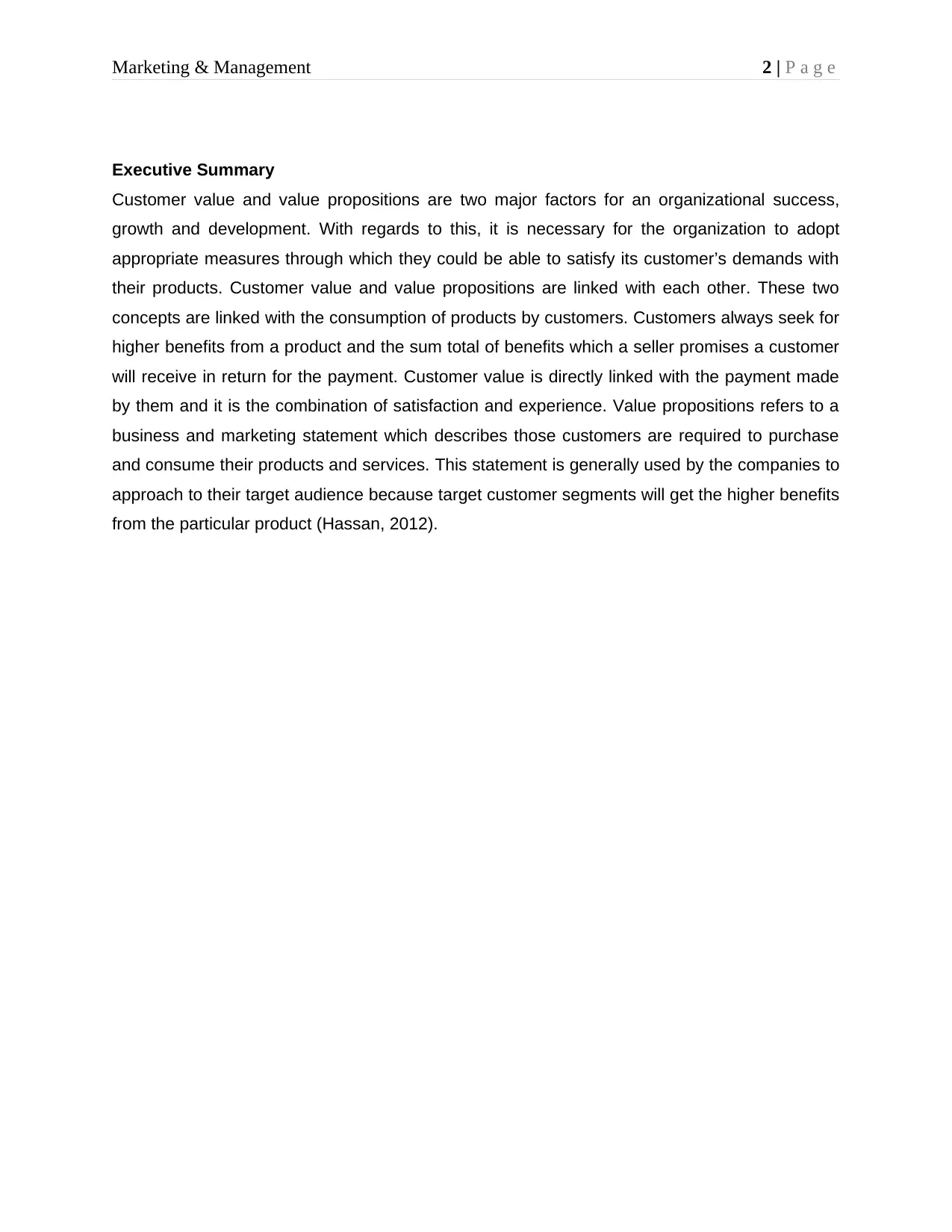
Marketing & Management 2 | P a g e
Executive Summary
Customer value and value propositions are two major factors for an organizational success,
growth and development. With regards to this, it is necessary for the organization to adopt
appropriate measures through which they could be able to satisfy its customer’s demands with
their products. Customer value and value propositions are linked with each other. These two
concepts are linked with the consumption of products by customers. Customers always seek for
higher benefits from a product and the sum total of benefits which a seller promises a customer
will receive in return for the payment. Customer value is directly linked with the payment made
by them and it is the combination of satisfaction and experience. Value propositions refers to a
business and marketing statement which describes those customers are required to purchase
and consume their products and services. This statement is generally used by the companies to
approach to their target audience because target customer segments will get the higher benefits
from the particular product (Hassan, 2012).
Executive Summary
Customer value and value propositions are two major factors for an organizational success,
growth and development. With regards to this, it is necessary for the organization to adopt
appropriate measures through which they could be able to satisfy its customer’s demands with
their products. Customer value and value propositions are linked with each other. These two
concepts are linked with the consumption of products by customers. Customers always seek for
higher benefits from a product and the sum total of benefits which a seller promises a customer
will receive in return for the payment. Customer value is directly linked with the payment made
by them and it is the combination of satisfaction and experience. Value propositions refers to a
business and marketing statement which describes those customers are required to purchase
and consume their products and services. This statement is generally used by the companies to
approach to their target audience because target customer segments will get the higher benefits
from the particular product (Hassan, 2012).
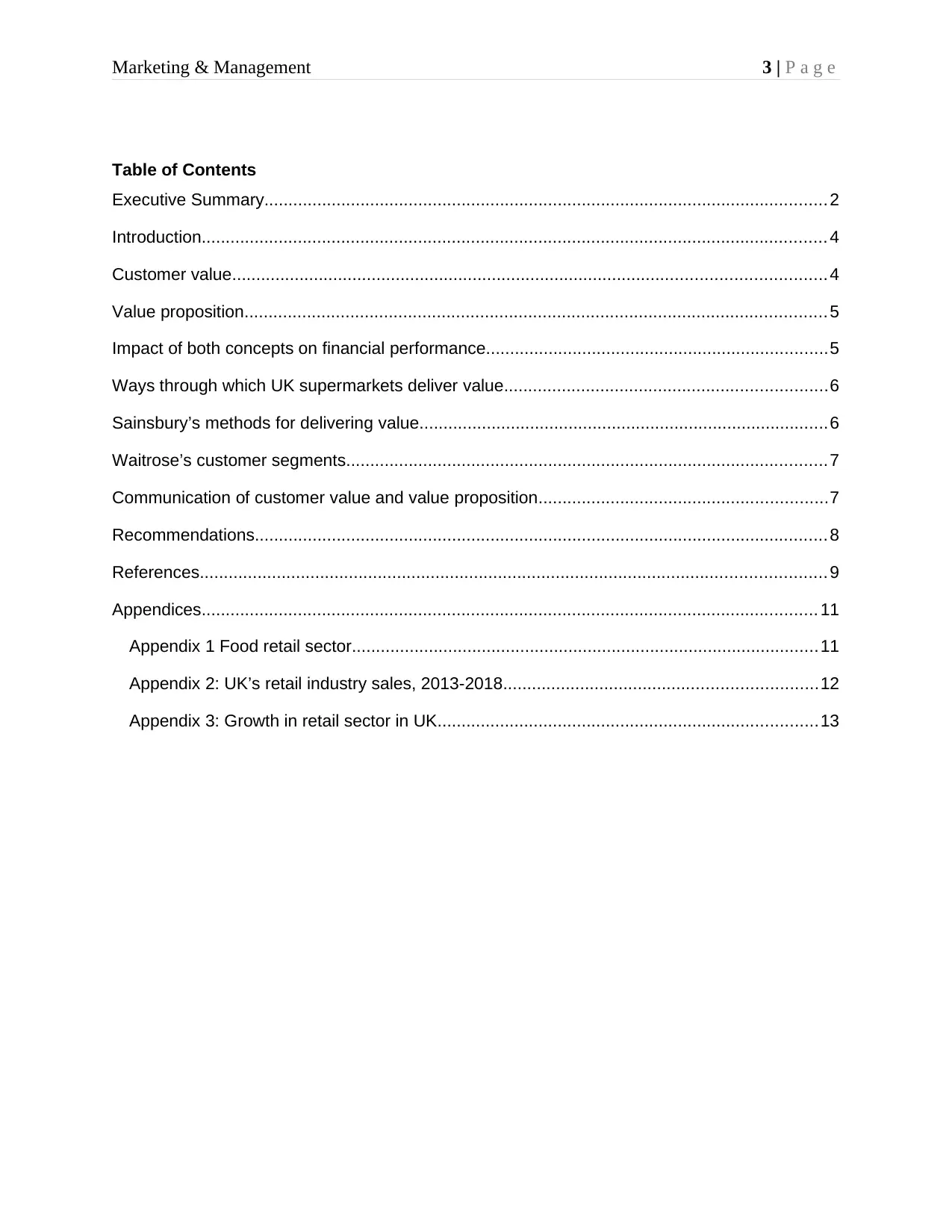
Marketing & Management 3 | P a g e
Table of Contents
Executive Summary..................................................................................................................... 2
Introduction.................................................................................................................................. 4
Customer value........................................................................................................................... 4
Value proposition......................................................................................................................... 5
Impact of both concepts on financial performance.......................................................................5
Ways through which UK supermarkets deliver value...................................................................6
Sainsbury’s methods for delivering value.....................................................................................6
Waitrose’s customer segments....................................................................................................7
Communication of customer value and value proposition............................................................7
Recommendations....................................................................................................................... 8
References.................................................................................................................................. 9
Appendices................................................................................................................................ 11
Appendix 1 Food retail sector.................................................................................................11
Appendix 2: UK’s retail industry sales, 2013-2018.................................................................12
Appendix 3: Growth in retail sector in UK...............................................................................13
Table of Contents
Executive Summary..................................................................................................................... 2
Introduction.................................................................................................................................. 4
Customer value........................................................................................................................... 4
Value proposition......................................................................................................................... 5
Impact of both concepts on financial performance.......................................................................5
Ways through which UK supermarkets deliver value...................................................................6
Sainsbury’s methods for delivering value.....................................................................................6
Waitrose’s customer segments....................................................................................................7
Communication of customer value and value proposition............................................................7
Recommendations....................................................................................................................... 8
References.................................................................................................................................. 9
Appendices................................................................................................................................ 11
Appendix 1 Food retail sector.................................................................................................11
Appendix 2: UK’s retail industry sales, 2013-2018.................................................................12
Appendix 3: Growth in retail sector in UK...............................................................................13
⊘ This is a preview!⊘
Do you want full access?
Subscribe today to unlock all pages.

Trusted by 1+ million students worldwide
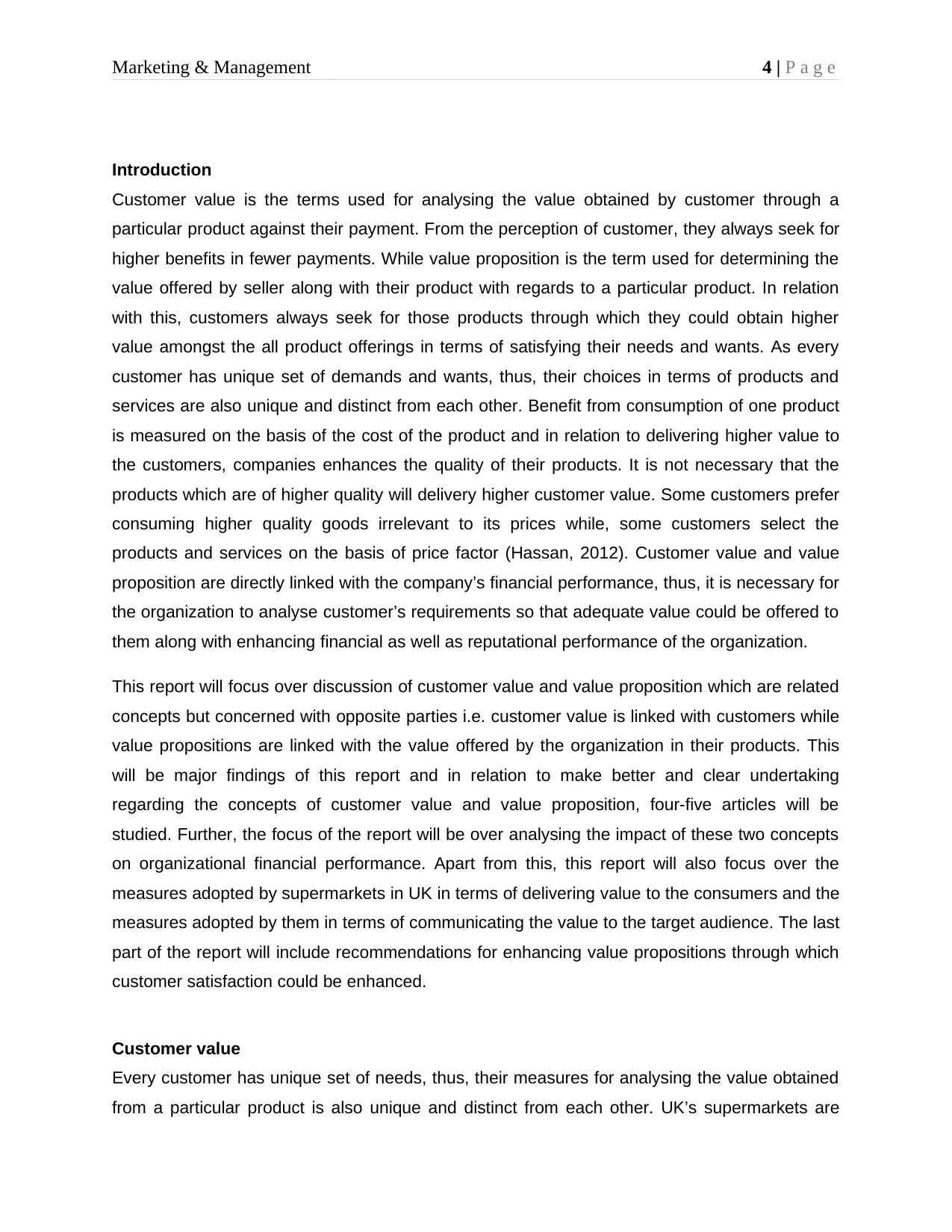
Marketing & Management 4 | P a g e
Introduction
Customer value is the terms used for analysing the value obtained by customer through a
particular product against their payment. From the perception of customer, they always seek for
higher benefits in fewer payments. While value proposition is the term used for determining the
value offered by seller along with their product with regards to a particular product. In relation
with this, customers always seek for those products through which they could obtain higher
value amongst the all product offerings in terms of satisfying their needs and wants. As every
customer has unique set of demands and wants, thus, their choices in terms of products and
services are also unique and distinct from each other. Benefit from consumption of one product
is measured on the basis of the cost of the product and in relation to delivering higher value to
the customers, companies enhances the quality of their products. It is not necessary that the
products which are of higher quality will delivery higher customer value. Some customers prefer
consuming higher quality goods irrelevant to its prices while, some customers select the
products and services on the basis of price factor (Hassan, 2012). Customer value and value
proposition are directly linked with the company’s financial performance, thus, it is necessary for
the organization to analyse customer’s requirements so that adequate value could be offered to
them along with enhancing financial as well as reputational performance of the organization.
This report will focus over discussion of customer value and value proposition which are related
concepts but concerned with opposite parties i.e. customer value is linked with customers while
value propositions are linked with the value offered by the organization in their products. This
will be major findings of this report and in relation to make better and clear undertaking
regarding the concepts of customer value and value proposition, four-five articles will be
studied. Further, the focus of the report will be over analysing the impact of these two concepts
on organizational financial performance. Apart from this, this report will also focus over the
measures adopted by supermarkets in UK in terms of delivering value to the consumers and the
measures adopted by them in terms of communicating the value to the target audience. The last
part of the report will include recommendations for enhancing value propositions through which
customer satisfaction could be enhanced.
Customer value
Every customer has unique set of needs, thus, their measures for analysing the value obtained
from a particular product is also unique and distinct from each other. UK’s supermarkets are
Introduction
Customer value is the terms used for analysing the value obtained by customer through a
particular product against their payment. From the perception of customer, they always seek for
higher benefits in fewer payments. While value proposition is the term used for determining the
value offered by seller along with their product with regards to a particular product. In relation
with this, customers always seek for those products through which they could obtain higher
value amongst the all product offerings in terms of satisfying their needs and wants. As every
customer has unique set of demands and wants, thus, their choices in terms of products and
services are also unique and distinct from each other. Benefit from consumption of one product
is measured on the basis of the cost of the product and in relation to delivering higher value to
the customers, companies enhances the quality of their products. It is not necessary that the
products which are of higher quality will delivery higher customer value. Some customers prefer
consuming higher quality goods irrelevant to its prices while, some customers select the
products and services on the basis of price factor (Hassan, 2012). Customer value and value
proposition are directly linked with the company’s financial performance, thus, it is necessary for
the organization to analyse customer’s requirements so that adequate value could be offered to
them along with enhancing financial as well as reputational performance of the organization.
This report will focus over discussion of customer value and value proposition which are related
concepts but concerned with opposite parties i.e. customer value is linked with customers while
value propositions are linked with the value offered by the organization in their products. This
will be major findings of this report and in relation to make better and clear undertaking
regarding the concepts of customer value and value proposition, four-five articles will be
studied. Further, the focus of the report will be over analysing the impact of these two concepts
on organizational financial performance. Apart from this, this report will also focus over the
measures adopted by supermarkets in UK in terms of delivering value to the consumers and the
measures adopted by them in terms of communicating the value to the target audience. The last
part of the report will include recommendations for enhancing value propositions through which
customer satisfaction could be enhanced.
Customer value
Every customer has unique set of needs, thus, their measures for analysing the value obtained
from a particular product is also unique and distinct from each other. UK’s supermarkets are
Paraphrase This Document
Need a fresh take? Get an instant paraphrase of this document with our AI Paraphraser
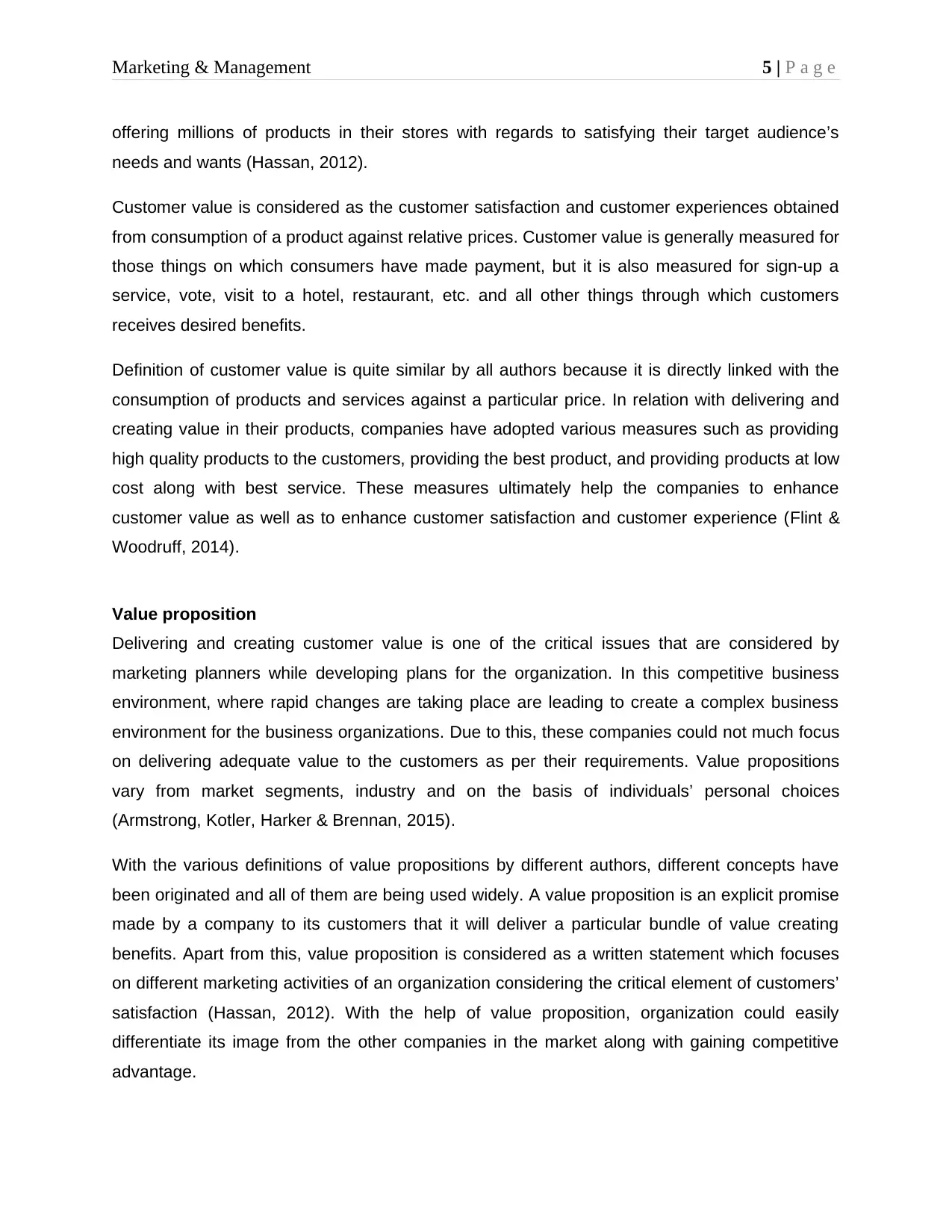
Marketing & Management 5 | P a g e
offering millions of products in their stores with regards to satisfying their target audience’s
needs and wants (Hassan, 2012).
Customer value is considered as the customer satisfaction and customer experiences obtained
from consumption of a product against relative prices. Customer value is generally measured for
those things on which consumers have made payment, but it is also measured for sign-up a
service, vote, visit to a hotel, restaurant, etc. and all other things through which customers
receives desired benefits.
Definition of customer value is quite similar by all authors because it is directly linked with the
consumption of products and services against a particular price. In relation with delivering and
creating value in their products, companies have adopted various measures such as providing
high quality products to the customers, providing the best product, and providing products at low
cost along with best service. These measures ultimately help the companies to enhance
customer value as well as to enhance customer satisfaction and customer experience (Flint &
Woodruff, 2014).
Value proposition
Delivering and creating customer value is one of the critical issues that are considered by
marketing planners while developing plans for the organization. In this competitive business
environment, where rapid changes are taking place are leading to create a complex business
environment for the business organizations. Due to this, these companies could not much focus
on delivering adequate value to the customers as per their requirements. Value propositions
vary from market segments, industry and on the basis of individuals’ personal choices
(Armstrong, Kotler, Harker & Brennan, 2015).
With the various definitions of value propositions by different authors, different concepts have
been originated and all of them are being used widely. A value proposition is an explicit promise
made by a company to its customers that it will deliver a particular bundle of value creating
benefits. Apart from this, value proposition is considered as a written statement which focuses
on different marketing activities of an organization considering the critical element of customers’
satisfaction (Hassan, 2012). With the help of value proposition, organization could easily
differentiate its image from the other companies in the market along with gaining competitive
advantage.
offering millions of products in their stores with regards to satisfying their target audience’s
needs and wants (Hassan, 2012).
Customer value is considered as the customer satisfaction and customer experiences obtained
from consumption of a product against relative prices. Customer value is generally measured for
those things on which consumers have made payment, but it is also measured for sign-up a
service, vote, visit to a hotel, restaurant, etc. and all other things through which customers
receives desired benefits.
Definition of customer value is quite similar by all authors because it is directly linked with the
consumption of products and services against a particular price. In relation with delivering and
creating value in their products, companies have adopted various measures such as providing
high quality products to the customers, providing the best product, and providing products at low
cost along with best service. These measures ultimately help the companies to enhance
customer value as well as to enhance customer satisfaction and customer experience (Flint &
Woodruff, 2014).
Value proposition
Delivering and creating customer value is one of the critical issues that are considered by
marketing planners while developing plans for the organization. In this competitive business
environment, where rapid changes are taking place are leading to create a complex business
environment for the business organizations. Due to this, these companies could not much focus
on delivering adequate value to the customers as per their requirements. Value propositions
vary from market segments, industry and on the basis of individuals’ personal choices
(Armstrong, Kotler, Harker & Brennan, 2015).
With the various definitions of value propositions by different authors, different concepts have
been originated and all of them are being used widely. A value proposition is an explicit promise
made by a company to its customers that it will deliver a particular bundle of value creating
benefits. Apart from this, value proposition is considered as a written statement which focuses
on different marketing activities of an organization considering the critical element of customers’
satisfaction (Hassan, 2012). With the help of value proposition, organization could easily
differentiate its image from the other companies in the market along with gaining competitive
advantage.
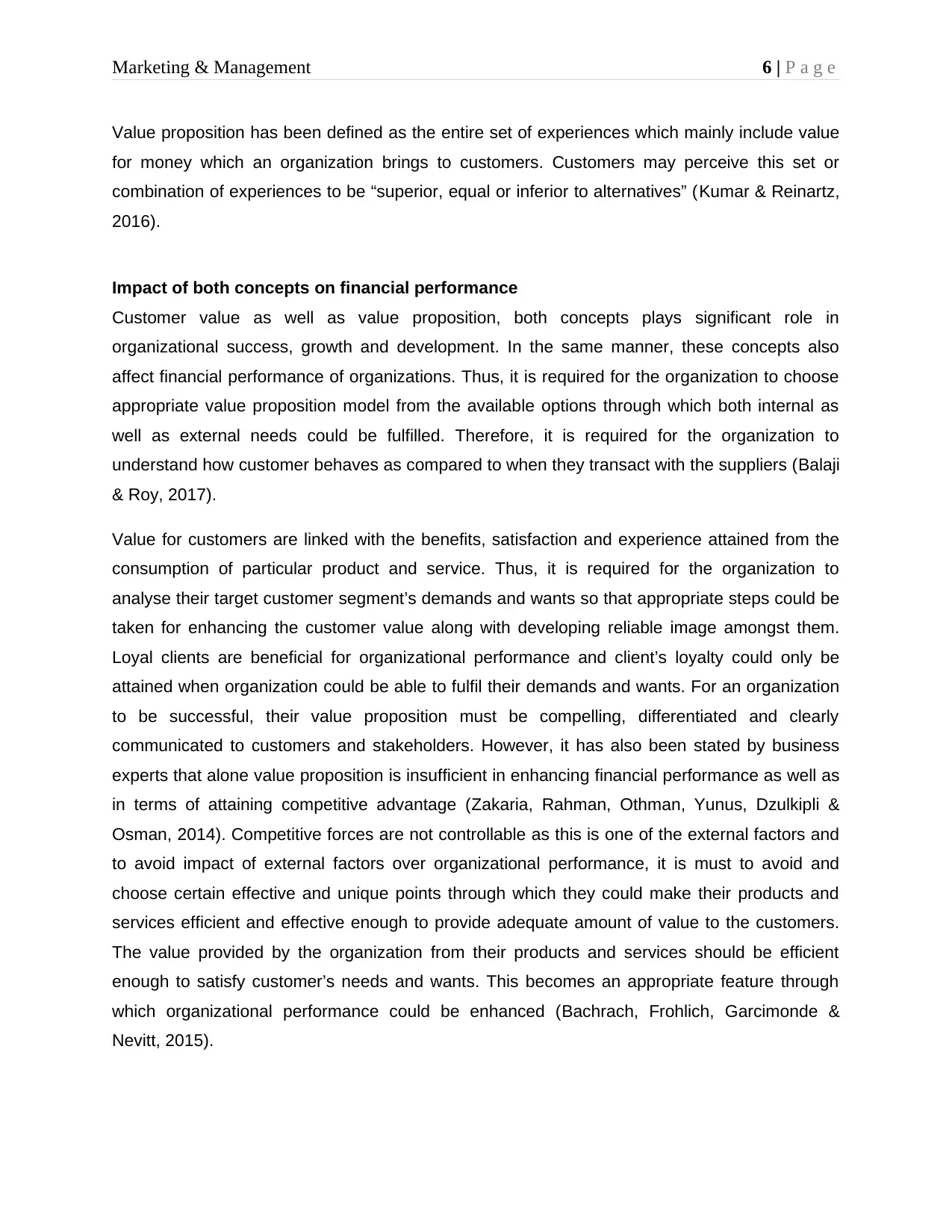
Marketing & Management 6 | P a g e
Value proposition has been defined as the entire set of experiences which mainly include value
for money which an organization brings to customers. Customers may perceive this set or
combination of experiences to be “superior, equal or inferior to alternatives” (Kumar & Reinartz,
2016).
Impact of both concepts on financial performance
Customer value as well as value proposition, both concepts plays significant role in
organizational success, growth and development. In the same manner, these concepts also
affect financial performance of organizations. Thus, it is required for the organization to choose
appropriate value proposition model from the available options through which both internal as
well as external needs could be fulfilled. Therefore, it is required for the organization to
understand how customer behaves as compared to when they transact with the suppliers (Balaji
& Roy, 2017).
Value for customers are linked with the benefits, satisfaction and experience attained from the
consumption of particular product and service. Thus, it is required for the organization to
analyse their target customer segment’s demands and wants so that appropriate steps could be
taken for enhancing the customer value along with developing reliable image amongst them.
Loyal clients are beneficial for organizational performance and client’s loyalty could only be
attained when organization could be able to fulfil their demands and wants. For an organization
to be successful, their value proposition must be compelling, differentiated and clearly
communicated to customers and stakeholders. However, it has also been stated by business
experts that alone value proposition is insufficient in enhancing financial performance as well as
in terms of attaining competitive advantage (Zakaria, Rahman, Othman, Yunus, Dzulkipli &
Osman, 2014). Competitive forces are not controllable as this is one of the external factors and
to avoid impact of external factors over organizational performance, it is must to avoid and
choose certain effective and unique points through which they could make their products and
services efficient and effective enough to provide adequate amount of value to the customers.
The value provided by the organization from their products and services should be efficient
enough to satisfy customer’s needs and wants. This becomes an appropriate feature through
which organizational performance could be enhanced (Bachrach, Frohlich, Garcimonde &
Nevitt, 2015).
Value proposition has been defined as the entire set of experiences which mainly include value
for money which an organization brings to customers. Customers may perceive this set or
combination of experiences to be “superior, equal or inferior to alternatives” (Kumar & Reinartz,
2016).
Impact of both concepts on financial performance
Customer value as well as value proposition, both concepts plays significant role in
organizational success, growth and development. In the same manner, these concepts also
affect financial performance of organizations. Thus, it is required for the organization to choose
appropriate value proposition model from the available options through which both internal as
well as external needs could be fulfilled. Therefore, it is required for the organization to
understand how customer behaves as compared to when they transact with the suppliers (Balaji
& Roy, 2017).
Value for customers are linked with the benefits, satisfaction and experience attained from the
consumption of particular product and service. Thus, it is required for the organization to
analyse their target customer segment’s demands and wants so that appropriate steps could be
taken for enhancing the customer value along with developing reliable image amongst them.
Loyal clients are beneficial for organizational performance and client’s loyalty could only be
attained when organization could be able to fulfil their demands and wants. For an organization
to be successful, their value proposition must be compelling, differentiated and clearly
communicated to customers and stakeholders. However, it has also been stated by business
experts that alone value proposition is insufficient in enhancing financial performance as well as
in terms of attaining competitive advantage (Zakaria, Rahman, Othman, Yunus, Dzulkipli &
Osman, 2014). Competitive forces are not controllable as this is one of the external factors and
to avoid impact of external factors over organizational performance, it is must to avoid and
choose certain effective and unique points through which they could make their products and
services efficient and effective enough to provide adequate amount of value to the customers.
The value provided by the organization from their products and services should be efficient
enough to satisfy customer’s needs and wants. This becomes an appropriate feature through
which organizational performance could be enhanced (Bachrach, Frohlich, Garcimonde &
Nevitt, 2015).
⊘ This is a preview!⊘
Do you want full access?
Subscribe today to unlock all pages.

Trusted by 1+ million students worldwide
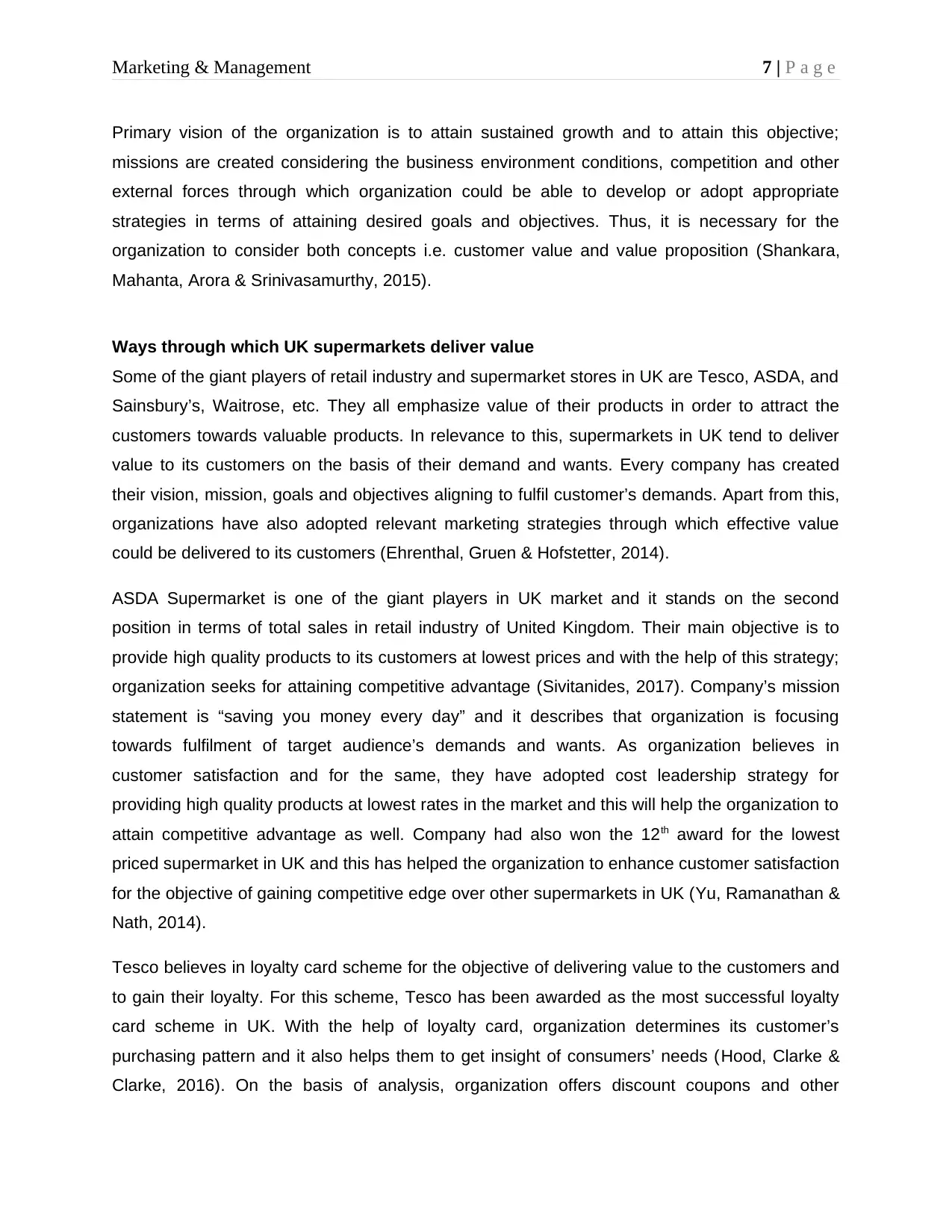
Marketing & Management 7 | P a g e
Primary vision of the organization is to attain sustained growth and to attain this objective;
missions are created considering the business environment conditions, competition and other
external forces through which organization could be able to develop or adopt appropriate
strategies in terms of attaining desired goals and objectives. Thus, it is necessary for the
organization to consider both concepts i.e. customer value and value proposition (Shankara,
Mahanta, Arora & Srinivasamurthy, 2015).
Ways through which UK supermarkets deliver value
Some of the giant players of retail industry and supermarket stores in UK are Tesco, ASDA, and
Sainsbury’s, Waitrose, etc. They all emphasize value of their products in order to attract the
customers towards valuable products. In relevance to this, supermarkets in UK tend to deliver
value to its customers on the basis of their demand and wants. Every company has created
their vision, mission, goals and objectives aligning to fulfil customer’s demands. Apart from this,
organizations have also adopted relevant marketing strategies through which effective value
could be delivered to its customers (Ehrenthal, Gruen & Hofstetter, 2014).
ASDA Supermarket is one of the giant players in UK market and it stands on the second
position in terms of total sales in retail industry of United Kingdom. Their main objective is to
provide high quality products to its customers at lowest prices and with the help of this strategy;
organization seeks for attaining competitive advantage (Sivitanides, 2017). Company’s mission
statement is “saving you money every day” and it describes that organization is focusing
towards fulfilment of target audience’s demands and wants. As organization believes in
customer satisfaction and for the same, they have adopted cost leadership strategy for
providing high quality products at lowest rates in the market and this will help the organization to
attain competitive advantage as well. Company had also won the 12th award for the lowest
priced supermarket in UK and this has helped the organization to enhance customer satisfaction
for the objective of gaining competitive edge over other supermarkets in UK (Yu, Ramanathan &
Nath, 2014).
Tesco believes in loyalty card scheme for the objective of delivering value to the customers and
to gain their loyalty. For this scheme, Tesco has been awarded as the most successful loyalty
card scheme in UK. With the help of loyalty card, organization determines its customer’s
purchasing pattern and it also helps them to get insight of consumers’ needs (Hood, Clarke &
Clarke, 2016). On the basis of analysis, organization offers discount coupons and other
Primary vision of the organization is to attain sustained growth and to attain this objective;
missions are created considering the business environment conditions, competition and other
external forces through which organization could be able to develop or adopt appropriate
strategies in terms of attaining desired goals and objectives. Thus, it is necessary for the
organization to consider both concepts i.e. customer value and value proposition (Shankara,
Mahanta, Arora & Srinivasamurthy, 2015).
Ways through which UK supermarkets deliver value
Some of the giant players of retail industry and supermarket stores in UK are Tesco, ASDA, and
Sainsbury’s, Waitrose, etc. They all emphasize value of their products in order to attract the
customers towards valuable products. In relevance to this, supermarkets in UK tend to deliver
value to its customers on the basis of their demand and wants. Every company has created
their vision, mission, goals and objectives aligning to fulfil customer’s demands. Apart from this,
organizations have also adopted relevant marketing strategies through which effective value
could be delivered to its customers (Ehrenthal, Gruen & Hofstetter, 2014).
ASDA Supermarket is one of the giant players in UK market and it stands on the second
position in terms of total sales in retail industry of United Kingdom. Their main objective is to
provide high quality products to its customers at lowest prices and with the help of this strategy;
organization seeks for attaining competitive advantage (Sivitanides, 2017). Company’s mission
statement is “saving you money every day” and it describes that organization is focusing
towards fulfilment of target audience’s demands and wants. As organization believes in
customer satisfaction and for the same, they have adopted cost leadership strategy for
providing high quality products at lowest rates in the market and this will help the organization to
attain competitive advantage as well. Company had also won the 12th award for the lowest
priced supermarket in UK and this has helped the organization to enhance customer satisfaction
for the objective of gaining competitive edge over other supermarkets in UK (Yu, Ramanathan &
Nath, 2014).
Tesco believes in loyalty card scheme for the objective of delivering value to the customers and
to gain their loyalty. For this scheme, Tesco has been awarded as the most successful loyalty
card scheme in UK. With the help of loyalty card, organization determines its customer’s
purchasing pattern and it also helps them to get insight of consumers’ needs (Hood, Clarke &
Clarke, 2016). On the basis of analysis, organization offers discount coupons and other
Paraphrase This Document
Need a fresh take? Get an instant paraphrase of this document with our AI Paraphraser
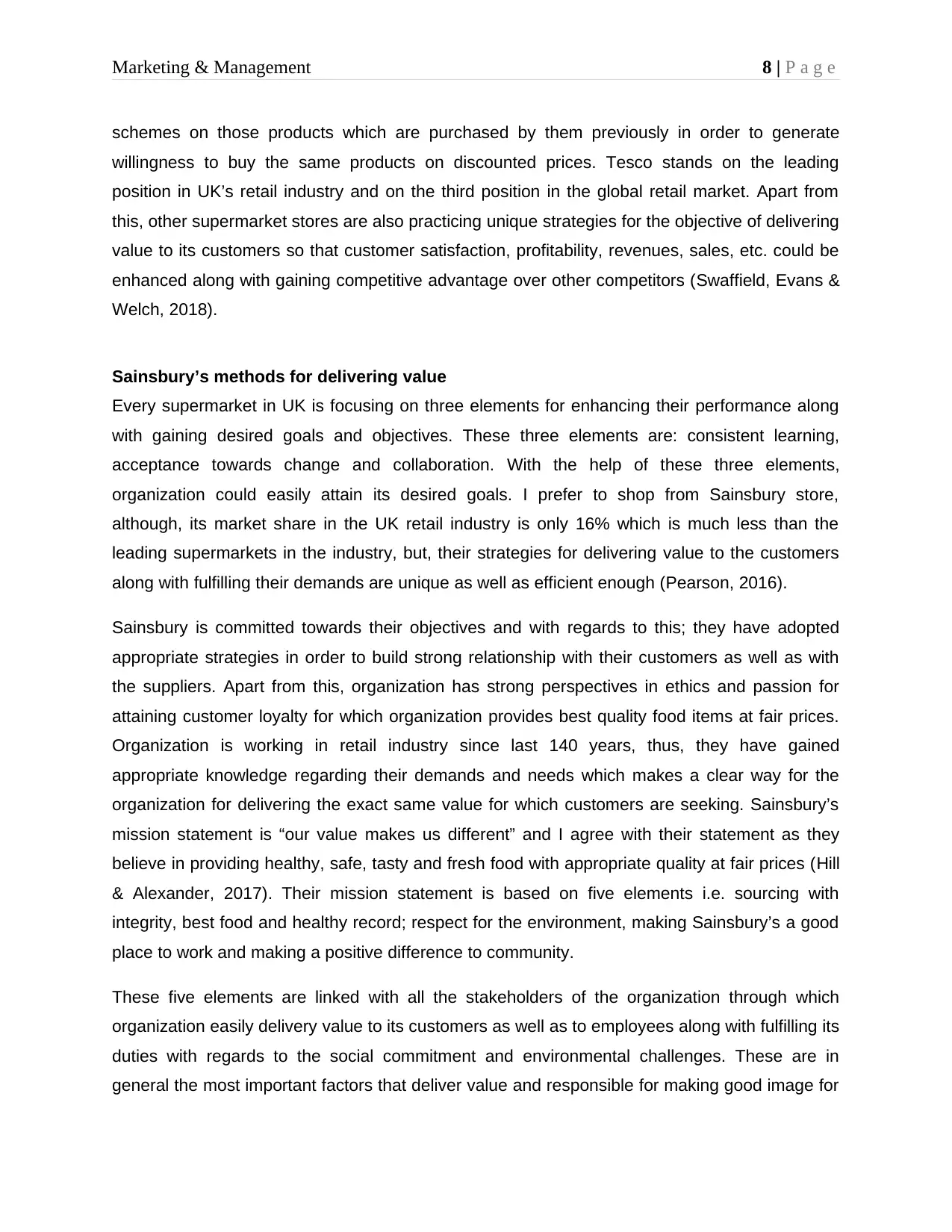
Marketing & Management 8 | P a g e
schemes on those products which are purchased by them previously in order to generate
willingness to buy the same products on discounted prices. Tesco stands on the leading
position in UK’s retail industry and on the third position in the global retail market. Apart from
this, other supermarket stores are also practicing unique strategies for the objective of delivering
value to its customers so that customer satisfaction, profitability, revenues, sales, etc. could be
enhanced along with gaining competitive advantage over other competitors (Swaffield, Evans &
Welch, 2018).
Sainsbury’s methods for delivering value
Every supermarket in UK is focusing on three elements for enhancing their performance along
with gaining desired goals and objectives. These three elements are: consistent learning,
acceptance towards change and collaboration. With the help of these three elements,
organization could easily attain its desired goals. I prefer to shop from Sainsbury store,
although, its market share in the UK retail industry is only 16% which is much less than the
leading supermarkets in the industry, but, their strategies for delivering value to the customers
along with fulfilling their demands are unique as well as efficient enough (Pearson, 2016).
Sainsbury is committed towards their objectives and with regards to this; they have adopted
appropriate strategies in order to build strong relationship with their customers as well as with
the suppliers. Apart from this, organization has strong perspectives in ethics and passion for
attaining customer loyalty for which organization provides best quality food items at fair prices.
Organization is working in retail industry since last 140 years, thus, they have gained
appropriate knowledge regarding their demands and needs which makes a clear way for the
organization for delivering the exact same value for which customers are seeking. Sainsbury’s
mission statement is “our value makes us different” and I agree with their statement as they
believe in providing healthy, safe, tasty and fresh food with appropriate quality at fair prices (Hill
& Alexander, 2017). Their mission statement is based on five elements i.e. sourcing with
integrity, best food and healthy record; respect for the environment, making Sainsbury’s a good
place to work and making a positive difference to community.
These five elements are linked with all the stakeholders of the organization through which
organization easily delivery value to its customers as well as to employees along with fulfilling its
duties with regards to the social commitment and environmental challenges. These are in
general the most important factors that deliver value and responsible for making good image for
schemes on those products which are purchased by them previously in order to generate
willingness to buy the same products on discounted prices. Tesco stands on the leading
position in UK’s retail industry and on the third position in the global retail market. Apart from
this, other supermarket stores are also practicing unique strategies for the objective of delivering
value to its customers so that customer satisfaction, profitability, revenues, sales, etc. could be
enhanced along with gaining competitive advantage over other competitors (Swaffield, Evans &
Welch, 2018).
Sainsbury’s methods for delivering value
Every supermarket in UK is focusing on three elements for enhancing their performance along
with gaining desired goals and objectives. These three elements are: consistent learning,
acceptance towards change and collaboration. With the help of these three elements,
organization could easily attain its desired goals. I prefer to shop from Sainsbury store,
although, its market share in the UK retail industry is only 16% which is much less than the
leading supermarkets in the industry, but, their strategies for delivering value to the customers
along with fulfilling their demands are unique as well as efficient enough (Pearson, 2016).
Sainsbury is committed towards their objectives and with regards to this; they have adopted
appropriate strategies in order to build strong relationship with their customers as well as with
the suppliers. Apart from this, organization has strong perspectives in ethics and passion for
attaining customer loyalty for which organization provides best quality food items at fair prices.
Organization is working in retail industry since last 140 years, thus, they have gained
appropriate knowledge regarding their demands and needs which makes a clear way for the
organization for delivering the exact same value for which customers are seeking. Sainsbury’s
mission statement is “our value makes us different” and I agree with their statement as they
believe in providing healthy, safe, tasty and fresh food with appropriate quality at fair prices (Hill
& Alexander, 2017). Their mission statement is based on five elements i.e. sourcing with
integrity, best food and healthy record; respect for the environment, making Sainsbury’s a good
place to work and making a positive difference to community.
These five elements are linked with all the stakeholders of the organization through which
organization easily delivery value to its customers as well as to employees along with fulfilling its
duties with regards to the social commitment and environmental challenges. These are in
general the most important factors that deliver value and responsible for making good image for
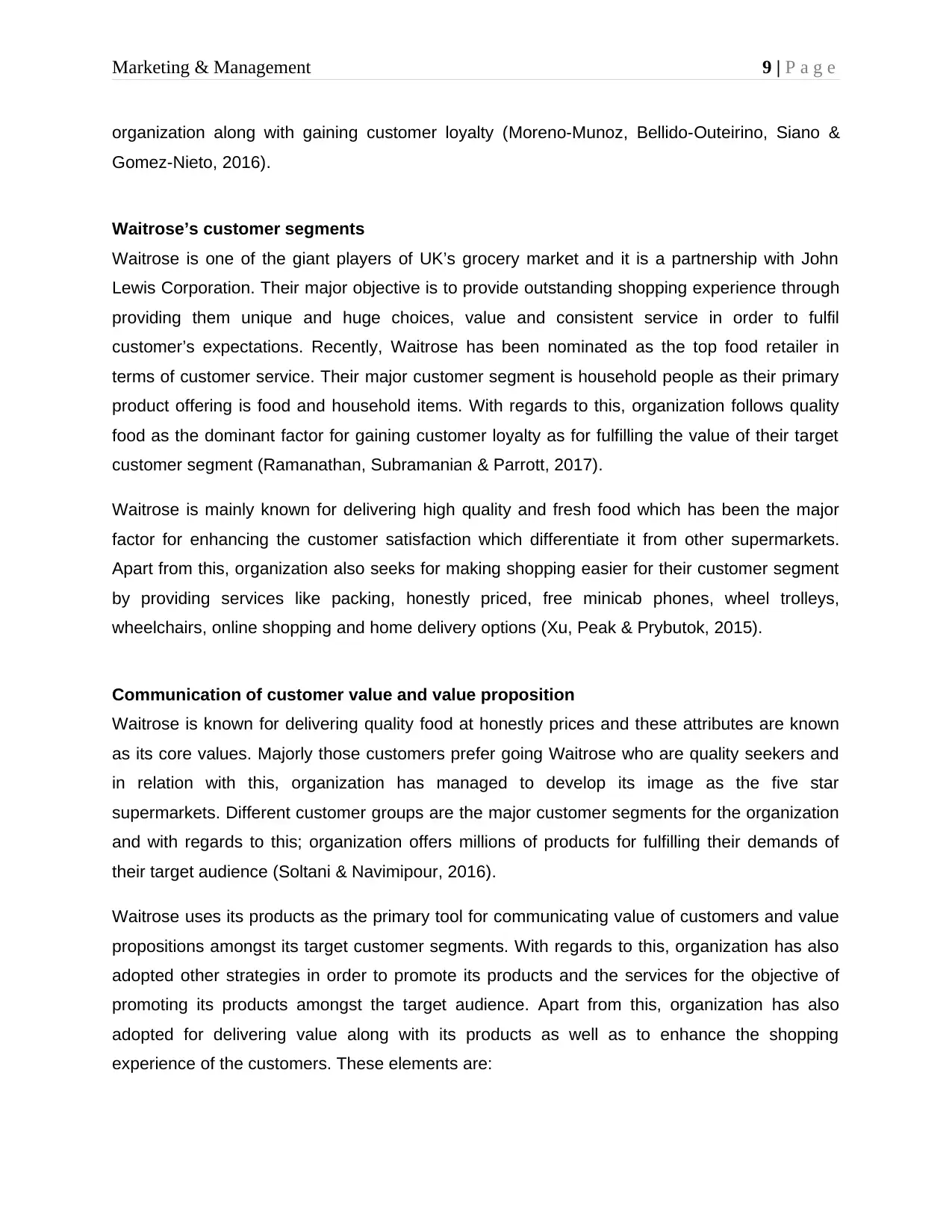
Marketing & Management 9 | P a g e
organization along with gaining customer loyalty (Moreno-Munoz, Bellido-Outeirino, Siano &
Gomez-Nieto, 2016).
Waitrose’s customer segments
Waitrose is one of the giant players of UK’s grocery market and it is a partnership with John
Lewis Corporation. Their major objective is to provide outstanding shopping experience through
providing them unique and huge choices, value and consistent service in order to fulfil
customer’s expectations. Recently, Waitrose has been nominated as the top food retailer in
terms of customer service. Their major customer segment is household people as their primary
product offering is food and household items. With regards to this, organization follows quality
food as the dominant factor for gaining customer loyalty as for fulfilling the value of their target
customer segment (Ramanathan, Subramanian & Parrott, 2017).
Waitrose is mainly known for delivering high quality and fresh food which has been the major
factor for enhancing the customer satisfaction which differentiate it from other supermarkets.
Apart from this, organization also seeks for making shopping easier for their customer segment
by providing services like packing, honestly priced, free minicab phones, wheel trolleys,
wheelchairs, online shopping and home delivery options (Xu, Peak & Prybutok, 2015).
Communication of customer value and value proposition
Waitrose is known for delivering quality food at honestly prices and these attributes are known
as its core values. Majorly those customers prefer going Waitrose who are quality seekers and
in relation with this, organization has managed to develop its image as the five star
supermarkets. Different customer groups are the major customer segments for the organization
and with regards to this; organization offers millions of products for fulfilling their demands of
their target audience (Soltani & Navimipour, 2016).
Waitrose uses its products as the primary tool for communicating value of customers and value
propositions amongst its target customer segments. With regards to this, organization has also
adopted other strategies in order to promote its products and the services for the objective of
promoting its products amongst the target audience. Apart from this, organization has also
adopted for delivering value along with its products as well as to enhance the shopping
experience of the customers. These elements are:
organization along with gaining customer loyalty (Moreno-Munoz, Bellido-Outeirino, Siano &
Gomez-Nieto, 2016).
Waitrose’s customer segments
Waitrose is one of the giant players of UK’s grocery market and it is a partnership with John
Lewis Corporation. Their major objective is to provide outstanding shopping experience through
providing them unique and huge choices, value and consistent service in order to fulfil
customer’s expectations. Recently, Waitrose has been nominated as the top food retailer in
terms of customer service. Their major customer segment is household people as their primary
product offering is food and household items. With regards to this, organization follows quality
food as the dominant factor for gaining customer loyalty as for fulfilling the value of their target
customer segment (Ramanathan, Subramanian & Parrott, 2017).
Waitrose is mainly known for delivering high quality and fresh food which has been the major
factor for enhancing the customer satisfaction which differentiate it from other supermarkets.
Apart from this, organization also seeks for making shopping easier for their customer segment
by providing services like packing, honestly priced, free minicab phones, wheel trolleys,
wheelchairs, online shopping and home delivery options (Xu, Peak & Prybutok, 2015).
Communication of customer value and value proposition
Waitrose is known for delivering quality food at honestly prices and these attributes are known
as its core values. Majorly those customers prefer going Waitrose who are quality seekers and
in relation with this, organization has managed to develop its image as the five star
supermarkets. Different customer groups are the major customer segments for the organization
and with regards to this; organization offers millions of products for fulfilling their demands of
their target audience (Soltani & Navimipour, 2016).
Waitrose uses its products as the primary tool for communicating value of customers and value
propositions amongst its target customer segments. With regards to this, organization has also
adopted other strategies in order to promote its products and the services for the objective of
promoting its products amongst the target audience. Apart from this, organization has also
adopted for delivering value along with its products as well as to enhance the shopping
experience of the customers. These elements are:
⊘ This is a preview!⊘
Do you want full access?
Subscribe today to unlock all pages.

Trusted by 1+ million students worldwide
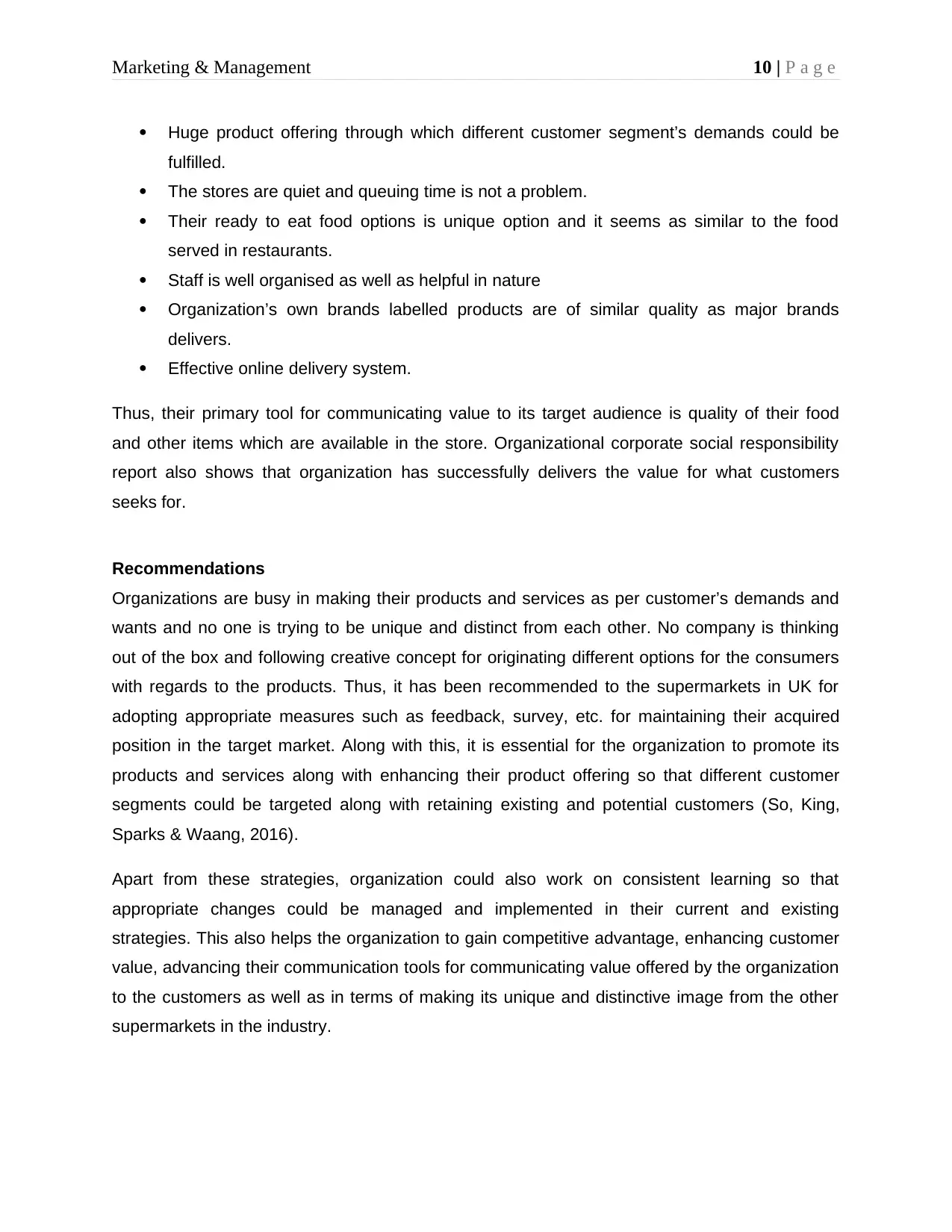
Marketing & Management 10 | P a g e
Huge product offering through which different customer segment’s demands could be
fulfilled.
The stores are quiet and queuing time is not a problem.
Their ready to eat food options is unique option and it seems as similar to the food
served in restaurants.
Staff is well organised as well as helpful in nature
Organization’s own brands labelled products are of similar quality as major brands
delivers.
Effective online delivery system.
Thus, their primary tool for communicating value to its target audience is quality of their food
and other items which are available in the store. Organizational corporate social responsibility
report also shows that organization has successfully delivers the value for what customers
seeks for.
Recommendations
Organizations are busy in making their products and services as per customer’s demands and
wants and no one is trying to be unique and distinct from each other. No company is thinking
out of the box and following creative concept for originating different options for the consumers
with regards to the products. Thus, it has been recommended to the supermarkets in UK for
adopting appropriate measures such as feedback, survey, etc. for maintaining their acquired
position in the target market. Along with this, it is essential for the organization to promote its
products and services along with enhancing their product offering so that different customer
segments could be targeted along with retaining existing and potential customers (So, King,
Sparks & Waang, 2016).
Apart from these strategies, organization could also work on consistent learning so that
appropriate changes could be managed and implemented in their current and existing
strategies. This also helps the organization to gain competitive advantage, enhancing customer
value, advancing their communication tools for communicating value offered by the organization
to the customers as well as in terms of making its unique and distinctive image from the other
supermarkets in the industry.
Huge product offering through which different customer segment’s demands could be
fulfilled.
The stores are quiet and queuing time is not a problem.
Their ready to eat food options is unique option and it seems as similar to the food
served in restaurants.
Staff is well organised as well as helpful in nature
Organization’s own brands labelled products are of similar quality as major brands
delivers.
Effective online delivery system.
Thus, their primary tool for communicating value to its target audience is quality of their food
and other items which are available in the store. Organizational corporate social responsibility
report also shows that organization has successfully delivers the value for what customers
seeks for.
Recommendations
Organizations are busy in making their products and services as per customer’s demands and
wants and no one is trying to be unique and distinct from each other. No company is thinking
out of the box and following creative concept for originating different options for the consumers
with regards to the products. Thus, it has been recommended to the supermarkets in UK for
adopting appropriate measures such as feedback, survey, etc. for maintaining their acquired
position in the target market. Along with this, it is essential for the organization to promote its
products and services along with enhancing their product offering so that different customer
segments could be targeted along with retaining existing and potential customers (So, King,
Sparks & Waang, 2016).
Apart from these strategies, organization could also work on consistent learning so that
appropriate changes could be managed and implemented in their current and existing
strategies. This also helps the organization to gain competitive advantage, enhancing customer
value, advancing their communication tools for communicating value offered by the organization
to the customers as well as in terms of making its unique and distinctive image from the other
supermarkets in the industry.
Paraphrase This Document
Need a fresh take? Get an instant paraphrase of this document with our AI Paraphraser
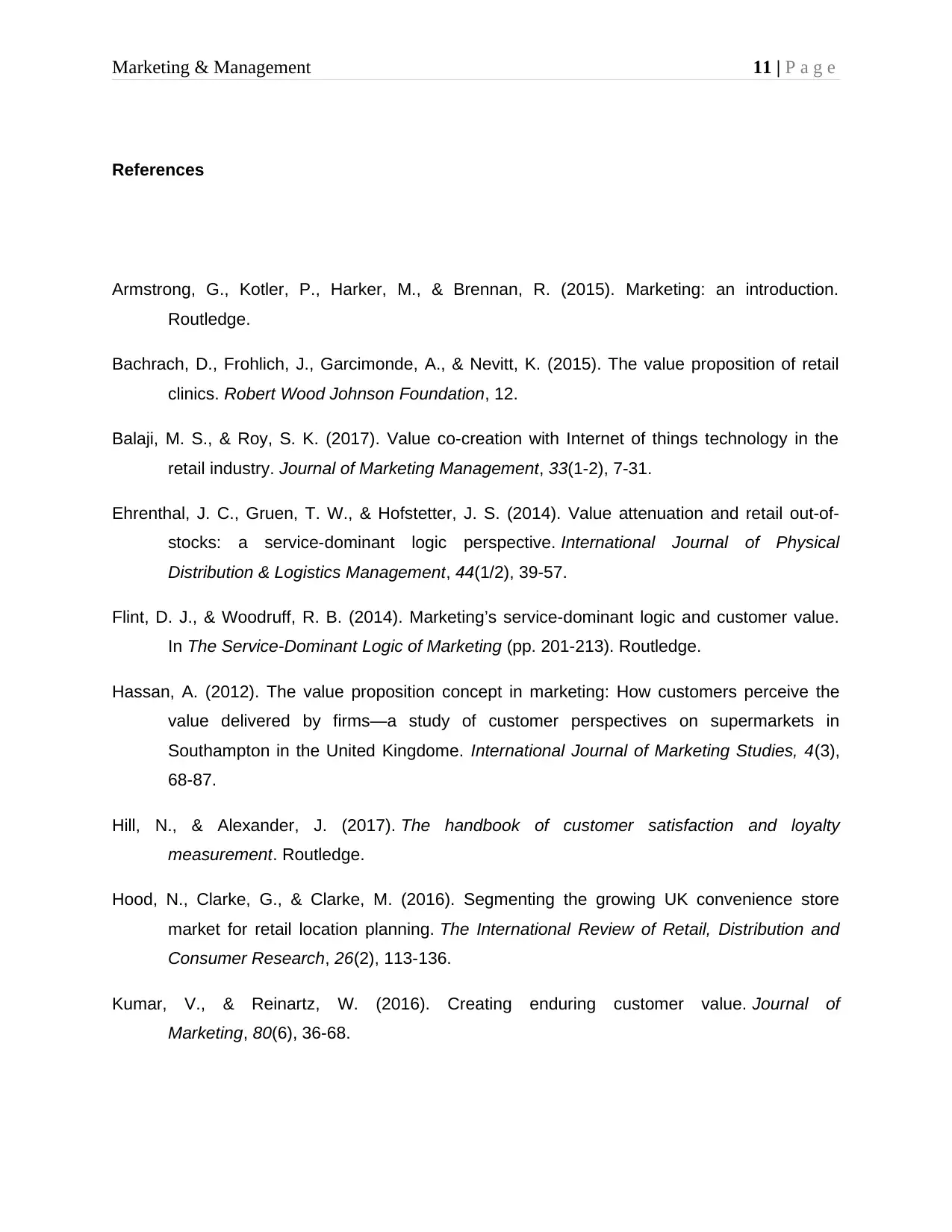
Marketing & Management 11 | P a g e
References
Armstrong, G., Kotler, P., Harker, M., & Brennan, R. (2015). Marketing: an introduction.
Routledge.
Bachrach, D., Frohlich, J., Garcimonde, A., & Nevitt, K. (2015). The value proposition of retail
clinics. Robert Wood Johnson Foundation, 12.
Balaji, M. S., & Roy, S. K. (2017). Value co-creation with Internet of things technology in the
retail industry. Journal of Marketing Management, 33(1-2), 7-31.
Ehrenthal, J. C., Gruen, T. W., & Hofstetter, J. S. (2014). Value attenuation and retail out-of-
stocks: a service-dominant logic perspective. International Journal of Physical
Distribution & Logistics Management, 44(1/2), 39-57.
Flint, D. J., & Woodruff, R. B. (2014). Marketing’s service-dominant logic and customer value.
In The Service-Dominant Logic of Marketing (pp. 201-213). Routledge.
Hassan, A. (2012). The value proposition concept in marketing: How customers perceive the
value delivered by firms—a study of customer perspectives on supermarkets in
Southampton in the United Kingdome. International Journal of Marketing Studies, 4(3),
68-87.
Hill, N., & Alexander, J. (2017). The handbook of customer satisfaction and loyalty
measurement. Routledge.
Hood, N., Clarke, G., & Clarke, M. (2016). Segmenting the growing UK convenience store
market for retail location planning. The International Review of Retail, Distribution and
Consumer Research, 26(2), 113-136.
Kumar, V., & Reinartz, W. (2016). Creating enduring customer value. Journal of
Marketing, 80(6), 36-68.
References
Armstrong, G., Kotler, P., Harker, M., & Brennan, R. (2015). Marketing: an introduction.
Routledge.
Bachrach, D., Frohlich, J., Garcimonde, A., & Nevitt, K. (2015). The value proposition of retail
clinics. Robert Wood Johnson Foundation, 12.
Balaji, M. S., & Roy, S. K. (2017). Value co-creation with Internet of things technology in the
retail industry. Journal of Marketing Management, 33(1-2), 7-31.
Ehrenthal, J. C., Gruen, T. W., & Hofstetter, J. S. (2014). Value attenuation and retail out-of-
stocks: a service-dominant logic perspective. International Journal of Physical
Distribution & Logistics Management, 44(1/2), 39-57.
Flint, D. J., & Woodruff, R. B. (2014). Marketing’s service-dominant logic and customer value.
In The Service-Dominant Logic of Marketing (pp. 201-213). Routledge.
Hassan, A. (2012). The value proposition concept in marketing: How customers perceive the
value delivered by firms—a study of customer perspectives on supermarkets in
Southampton in the United Kingdome. International Journal of Marketing Studies, 4(3),
68-87.
Hill, N., & Alexander, J. (2017). The handbook of customer satisfaction and loyalty
measurement. Routledge.
Hood, N., Clarke, G., & Clarke, M. (2016). Segmenting the growing UK convenience store
market for retail location planning. The International Review of Retail, Distribution and
Consumer Research, 26(2), 113-136.
Kumar, V., & Reinartz, W. (2016). Creating enduring customer value. Journal of
Marketing, 80(6), 36-68.
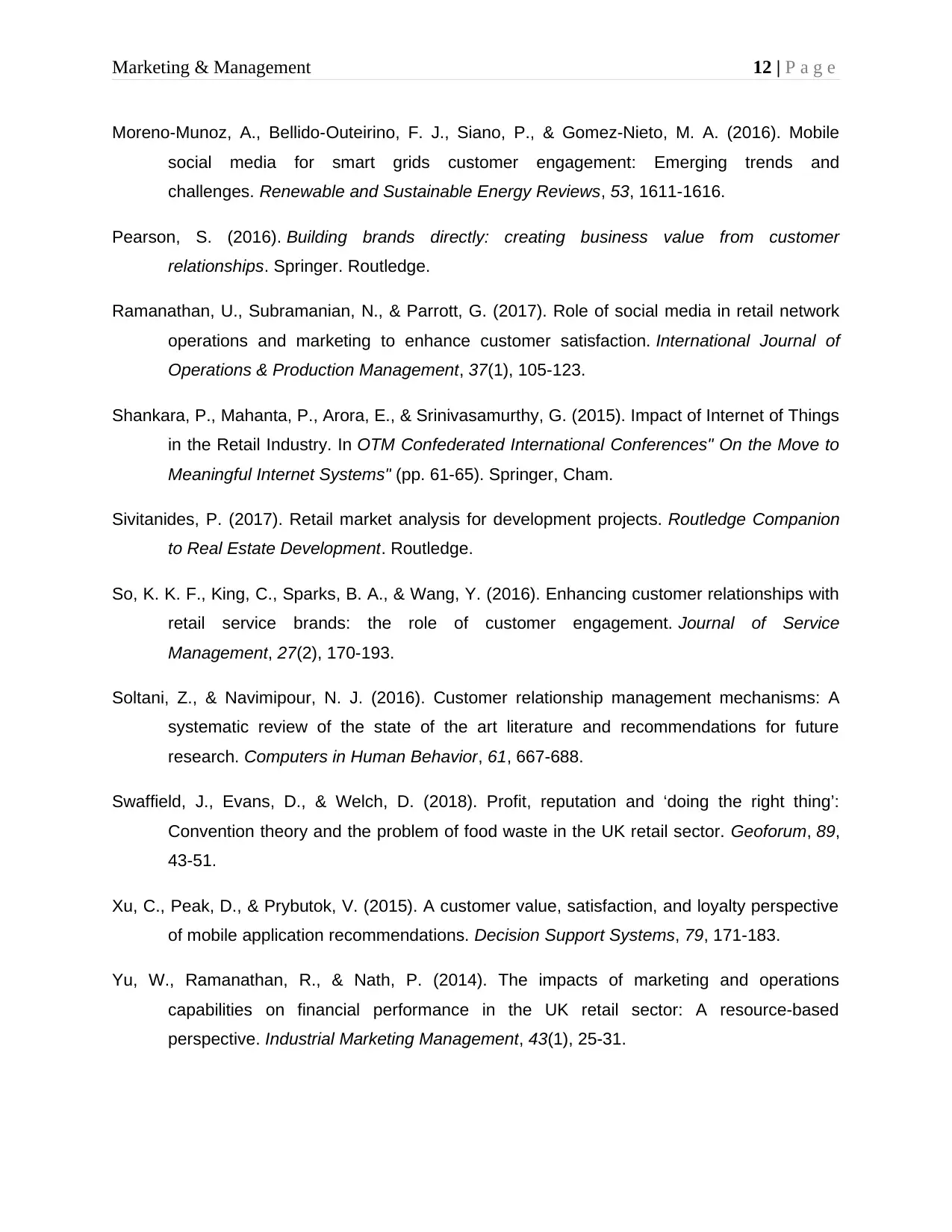
Marketing & Management 12 | P a g e
Moreno-Munoz, A., Bellido-Outeirino, F. J., Siano, P., & Gomez-Nieto, M. A. (2016). Mobile
social media for smart grids customer engagement: Emerging trends and
challenges. Renewable and Sustainable Energy Reviews, 53, 1611-1616.
Pearson, S. (2016). Building brands directly: creating business value from customer
relationships. Springer. Routledge.
Ramanathan, U., Subramanian, N., & Parrott, G. (2017). Role of social media in retail network
operations and marketing to enhance customer satisfaction. International Journal of
Operations & Production Management, 37(1), 105-123.
Shankara, P., Mahanta, P., Arora, E., & Srinivasamurthy, G. (2015). Impact of Internet of Things
in the Retail Industry. In OTM Confederated International Conferences" On the Move to
Meaningful Internet Systems" (pp. 61-65). Springer, Cham.
Sivitanides, P. (2017). Retail market analysis for development projects. Routledge Companion
to Real Estate Development. Routledge.
So, K. K. F., King, C., Sparks, B. A., & Wang, Y. (2016). Enhancing customer relationships with
retail service brands: the role of customer engagement. Journal of Service
Management, 27(2), 170-193.
Soltani, Z., & Navimipour, N. J. (2016). Customer relationship management mechanisms: A
systematic review of the state of the art literature and recommendations for future
research. Computers in Human Behavior, 61, 667-688.
Swaffield, J., Evans, D., & Welch, D. (2018). Profit, reputation and ‘doing the right thing’:
Convention theory and the problem of food waste in the UK retail sector. Geoforum, 89,
43-51.
Xu, C., Peak, D., & Prybutok, V. (2015). A customer value, satisfaction, and loyalty perspective
of mobile application recommendations. Decision Support Systems, 79, 171-183.
Yu, W., Ramanathan, R., & Nath, P. (2014). The impacts of marketing and operations
capabilities on financial performance in the UK retail sector: A resource-based
perspective. Industrial Marketing Management, 43(1), 25-31.
Moreno-Munoz, A., Bellido-Outeirino, F. J., Siano, P., & Gomez-Nieto, M. A. (2016). Mobile
social media for smart grids customer engagement: Emerging trends and
challenges. Renewable and Sustainable Energy Reviews, 53, 1611-1616.
Pearson, S. (2016). Building brands directly: creating business value from customer
relationships. Springer. Routledge.
Ramanathan, U., Subramanian, N., & Parrott, G. (2017). Role of social media in retail network
operations and marketing to enhance customer satisfaction. International Journal of
Operations & Production Management, 37(1), 105-123.
Shankara, P., Mahanta, P., Arora, E., & Srinivasamurthy, G. (2015). Impact of Internet of Things
in the Retail Industry. In OTM Confederated International Conferences" On the Move to
Meaningful Internet Systems" (pp. 61-65). Springer, Cham.
Sivitanides, P. (2017). Retail market analysis for development projects. Routledge Companion
to Real Estate Development. Routledge.
So, K. K. F., King, C., Sparks, B. A., & Wang, Y. (2016). Enhancing customer relationships with
retail service brands: the role of customer engagement. Journal of Service
Management, 27(2), 170-193.
Soltani, Z., & Navimipour, N. J. (2016). Customer relationship management mechanisms: A
systematic review of the state of the art literature and recommendations for future
research. Computers in Human Behavior, 61, 667-688.
Swaffield, J., Evans, D., & Welch, D. (2018). Profit, reputation and ‘doing the right thing’:
Convention theory and the problem of food waste in the UK retail sector. Geoforum, 89,
43-51.
Xu, C., Peak, D., & Prybutok, V. (2015). A customer value, satisfaction, and loyalty perspective
of mobile application recommendations. Decision Support Systems, 79, 171-183.
Yu, W., Ramanathan, R., & Nath, P. (2014). The impacts of marketing and operations
capabilities on financial performance in the UK retail sector: A resource-based
perspective. Industrial Marketing Management, 43(1), 25-31.
⊘ This is a preview!⊘
Do you want full access?
Subscribe today to unlock all pages.

Trusted by 1+ million students worldwide
1 out of 16
Related Documents
Your All-in-One AI-Powered Toolkit for Academic Success.
+13062052269
info@desklib.com
Available 24*7 on WhatsApp / Email
![[object Object]](/_next/static/media/star-bottom.7253800d.svg)
Unlock your academic potential
Copyright © 2020–2025 A2Z Services. All Rights Reserved. Developed and managed by ZUCOL.





